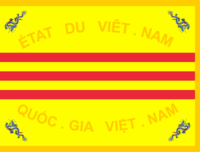Vietnamese National Army
| Vietnamese National Army (VNA) Quân đội Quốc gia Việt Nam |
|
|---|---|

|
|
| Active | 1949–1955 |
| Country | State of Vietnam |
| Allegiance | Chief of State of Vietnam |
| Type | Army |
| Role | Maintain order and internal security within the State of Vietnam Fight communist troops Defend the borders of the French Union. |
| Size |
As of July 1954 -167,700 men -37,800 auxiliaries (total: 205,500) |
| Engagements |
First Indochina War (1949–1954) Battle of Saigon (1955) |
| Commanders | |
| Notable commanders |
Nguyễn Văn Hinh Trung tướng  Tham mưu trưởng |
On March 8, 1949, after the Élysée Accords, the State of Vietnam was recognized by France as an independent country ruled by Vietnamese Emperor Bảo Đại. The Vietnamese National Army or Vietnam National Army (Vietnamese: Quân đội Quốc gia Việt Nam, "National Army of Vietnam", French: Armée Nationale Vietnamienne, "Vietnamese National Army") was the State of Vietnam's military force created shortly after that. It was commanded by Vietnamese General Hinh and was loyal to Bảo Đại. The VNA fought in joint operations with the French Union's French Far East Expeditionary Corps (CEFEO) against the communist Viet Minh forces led by Ho Chi Minh. Different units within the VNA fought in a wide range of campaigns including the Battle of Nà Sản (1952), Operation Hautes Alpes (1953), Operation Atlas (1953) and the Battle of Dien Bien Phu (1954).
With the departure of the French Far East Expeditionary Corps from Indochina in 1956, the VNA was reorganized under American tutelage as the Army of the Republic of Vietnam.
While loyalist to the Chief of State of Vietnam Emperor Bảo Đại, the VNA fought along the French Union forces against the communist Viet Minh led by Ho Chi Minh during the First Indochina War until 1954 and the partition of Vietnam.
...
Wikipedia
